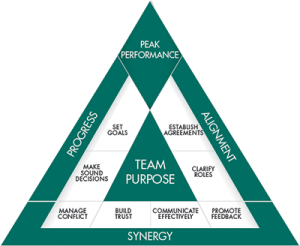Peak Teams: An Innovative Model for High-Performing Teams

How to make the connection between exceptional leaders and high-performing teams.
In today’s engineering and construction (E&C) industry, it is more important than ever to develop extraordinary leaders—those who clearly articulate direction, leverage and align resources to maximize opportunity, and inspire and motivate greatness in others.
But truly exceptional leaders also have a special ability to build great teams. As we look across the industry to our peers, partners and competitors, the mantra is the same: We need more talent, whether that is increased performance among our people or just more talented team members in our organizations.
In fact, availability of talent is the No. 1 challenge facing our industry today. “FMI’s 2017 Talent Development Survey” found that 89% of E&C organizations currently face talent shortages. As organizations try to solve this challenge, they begin focusing on highly effective leadership, building teams within the organization that increase performance, and retaining the people they do have. Effective leadership, especially team leadership, can help organizations increase their capabilities and retain the talent they want to keep.
Engineering and Construction: The Ultimate Team Sport
As we look across the E&C industry, we see a multifaceted and integrated system of people and behaviors as well as technology and processes that are aimed at addressing bigger and more complex problems. The rise of megaprojects (i.e., projects of $500 million or larger) is one example of the increased complexity leaders face in today’s business environment. Mega or not, today’s projects demand more information, more coordination and more integration than ever before.
This new paradigm creates an environment where larger, more diverse teams must operate more efficiently across departments, organizations and geographies—a trend that’s being driven by owner expectations for faster, better and cheaper project outcomes. In the simplest of environments, the most efficient team is a team of one that requires only self-leadership and minimal coordination to complete a task.
But look at your daily schedule and you’ll see that the time dedicated to individual contribution is very limited. Once teams expand beyond one person, the required amount of coordination and integration grows exponentially. According to a recent study,1 the average person receives 304 weekly business emails and checks his or her email 36 times per hour. The average team member attends 62 meetings monthly, and half of the time, these meetings are considered wasted time.
Let’s face it—we waste a lot of time. Addressing these challenges begins with taking a step back and fundamentally recognizing that engineering and construction is a team sport where synergy, alignment and commitment to one common purpose make or break success. This should be followed by a renewed focus on how to effectively lead teams that operate at peak performance despite generational differences and rising complexity. Exceptional team leaders maximize available talent while creating a magnetic pull for the types of people today’s organizations increasingly need.
Peak Leadership: The Individual Leader Solution

Source: Model is based on in-depth industry research.
Leadership’s role in this increasingly complex environment can be dramatic. In fact, leadership development can be an organization’s competitive advantage, or it can be its Achilles heel. So how can an organization know if the leaders are achieving success? FMI’s experience in E&C has led to the development of the Peak Leader model, which helps evaluate leadership performance and plan for individual leader development based on eight essential leadership behaviors: set direction, think strategically, align resources, motivate and inspire, focus on others, execute and follow through, lead within and develop talent (Exhibit 1).
Let’s look at two leadership behaviors that serve as strong predictors of overall success and which are amplified when used within teams:
Set direction: Establish the why, how and where. One of leadership’s primary responsibilities is charting the team’s course. Defining objectives, connecting those objectives with the larger organizational objectives, and then showing how each team member contributes to success can be liberating for high performers on any team. With a clear direction, team members are empowered to fully engage, solve problems and act intentionally to achieve the overall organizational objectives. When the direction is unclear, team members must constantly check in for additional guidance, get permission for any change in action, and constantly seek reassurance that what they are doing is right. Remember those 304 emails a week? This is a symptom of leaders who are not effectively setting direction. If your team members constantly check in on small details, ask for your permission or “run stuff by you,” it may be an indication that you can increase your leadership effectiveness by clearly setting direction and engaging your team to pursue results on their own.
Execute and follow through. Many leaders in the E&C industry worry that an increased focus on leadership behaviors, such as setting direction and creating a project team purpose, will distract them from getting their work done. To resolve this concern, we return to the Peak Leader model and look to engage the leadership behaviors around execute and follow through. When leaders are performing at a high level in “execute and follow through,” there is clarity around how they will communicate as leaders and how the systems and processes will ensure individual accountability. Far too often in our industry, leaders overlook their communication systems, relying too heavily on email and phone calls to address immediate issues and underestimating the power of highly effective meetings and team integration in communication. For example, do your team members know the most important communication points and the required timing and extent of such information across the team?
To answer this question, the military uses a system called the Commander’s Critical Information Requirement (CCIR), which clearly defines what information must be conveyed to senior leaders and across teams to help everyone make timely adjustments and achieve given objectives. The same system can be applied in construction, where equipment utilization, manpower changes, critical path schedule disruptions and safety concerns should all be factored in. The key is to keep the list short and to let everyone know what those items are. Other than the CCIR items, most actions and information are handled at the execution level. Does your team know what is most critical and important to you and to the organization? Do you talk about these items as critical rather than just another item on the meeting agenda? As a leader, if you are not clear about what critical information is needed to make decisions, then there is a strong probability that your team doesn’t know either. As such, the team might miss the opportunity to identify vital information in a timely manner.
These are just two of the eight leadership behaviors that FMI has found to be critical to success in our industry. Each of the eight total leadership behaviors can be tied to team performance, but let’s take a deeper look at how these two can be applied directly to high-performing teams.
Peak Teams: An Innovative Team Leadership Solution

Source: Model is based on in-depth industry research.
When you stop and consider the drivers of high-performing teams, whether examining dynasty- like sports franchises or reflecting on those construction project teams that consistently exceed delivery expectations, these foundational principles always seem to be in place (Exhibit 2):
- A clear sense of common team purpose.
- A deep synergy and an abiding trust among team members.
- A clear alignment of roles and team behaviors.
- Well-established and clearly communicated processes and systems that enable timely decisions, create stretch goals, elevate accountability and deliver results as a unit of one.
Think about the last time you were on a team that delivered consistently high-quality outcomes and results. That team probably operated with a sense of having one, unified goal versus acting as a group of individuals pursuing separate targets. Team trust and open lines of candid, effective communication are more likely prevalent, bringing speed and effectiveness to addressing obstacles and overcoming schedule challenges.
It is also likely that a set of clear team rules and roles were in place, thus eliminating ambiguity related to performance expectations and personal accountabilities, and creating little wasted motion or lost production time.
Before game day or the start of a new project, these behavioral norms, processes and expectations have already been put in place, reinforced and practiced. This is all done with the understanding that when the game begins and challenges of unforeseen obstacles arise or changes in owner expectations occur, these behaviors and processes allow teammates to lean on one another. This kind of framework can help leverage the team’s collective wisdom and skills and ultimately lead to better results.
It is fair to say these high-performing teams usually have exceptional leaders, putting in place the foundations and instilling the principles of unified purpose (setting direction) and reinforcing the set of processes and behaviors in a way that unifies a group of individuals to deliver exceptional results (execute and follow through). You will also notice that these leaders create a deep sense of ownership and “buy-in” across the team and establish a group of co-leaders committed to consistently delivering the team’s purpose and mission. Such leaders also build a team where each member believes in and fights for the set goals, and where everyone is held accountable for execution, follow-through and delivery.
Great Teams Often Win, Lose Occasionally but Never Stop Growing
Strong leaders understand there is no such thing as a “success guarantee.” Sometimes no matter what we do, setbacks occur. And yet, these same leaders know that the likelihood of success is far greater when time is invested in building and reinforcing Peak Team foundations versus leaving expected behaviors and processes to chance. They also know that strong teams learn a great deal from their losses and have formalized those mechanisms (i.e., formal debriefs and real-time feedback) that allow the team to quickly adjust plans and rethink methods.
A recent industry executive study revealed that more than 90% believe that a lack of collaboration (i.e., teamwork—both internally and externally) stands as one of the top-three challenges slowing performance today. A similar study estimated that up to 25% gains in productivity are achievable when team collaboration is optimized (i.e., synergized, aligned and unified). No wonder elevating team leadership is considered a top development priority by more than 85% of executives polled!
Winning the team game in our industry today and in the future will continue to require the formation of highly synergized, aligned and progress-oriented Peak Teams. Building and reinforcing these kinds of teams, whether in the boardroom, at weekly operations meetings or on the job site, remain, the signature of exceptional leaders and sustainable organizations.
.png)


